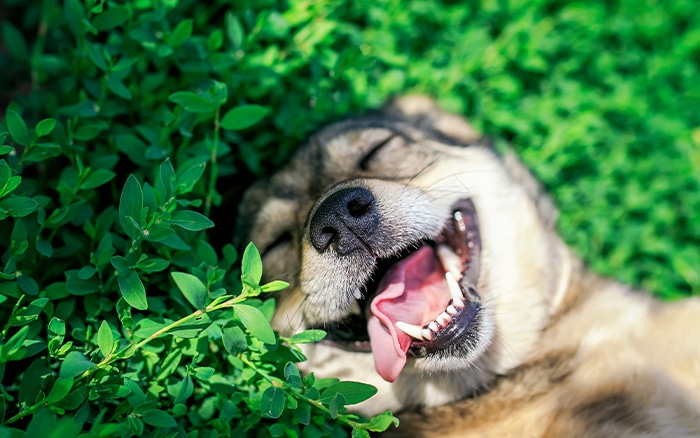If you’re a dog owner, you know how much fun it can be to play with a dog in the garden.
My dogs
I still have fond memories of bounding about with my family’s two dogs when I was growing up. A dog and a handsome garden don’t have to be incompatible, of course. Here are some simple ways to make your garden dog-friendly that will be a hit not only with your dog but also with your plants.
Garden design
Creating zones within your garden can be a great way to add intrigue for your dog at the same time as protecting plants.
Dog Zone
If you have space, make a designated digging area with gravel or bark chippings and bury a bone, a favourite toy, or a few treats in this area.
This will encourage your dog to dig there, rather than digging in other places where they might cause damage. Zone-off borders by creating a barrier between them and dog-friendly spaces.

Use edging panels to fence borders off or put in raised beds to keep dogs off plants. Enforce the boundary by moving your dog out of borders when they overstep the line.
Paw Patrol
If your dog is territorial, you might find that he or she wants to patrol the perimeter of your fence. A good way to allow for this without allowing for plant damage is to make a designated dog path through your borders.
Move vulnerable plants out of the way and wind the path around more robust varieties. Your dog can then use this path whilst on patrol, without doing damage.
Lawn care

Dog paws can trample down tender grass and cause bald patches to appear in your lawn.
If you’re re-laying or repairing the lawn, it’s a good idea to choose hard-wearing lawn seed to prevent this from happening.
Seed Mix
Seed mixes which contain species such as Dwarf Ryegrass will provide a full, thick turf. It will be more resistant to wear and tear and is ideal for dog-friendly gardens.
If you have problems with your dog digging up your lawn, see my top tips on fixing this problem.
Burn
Another possible lawn problem for dog owners is that dogs sometimes leave brown burn marks on the grass when they urinate. This is due to the high nitrogen content of dog urine.
Female dogs are often worse for this than males because females tend to deposit urine in one place (rather than spraying widely), making their urine more concentrated on the grass.
Hydration
You can buy products to put in your dog’s water, but I find that a better approach is simply to keep your dog properly hydrated. This dilutes their urine and makes burn marks less likely.

Tip
Another good tip is to water the grass after your dog has been. Once the nitrogen is diluted with water, it will fertilise your lawn instead of killing it! If this is a big problem for you, you could try training your dog to urinate on a gravelled or mulched area of the garden instead. Reward her with a treat when she uses the desired spot.
Dog-friendly plants

Great plant choices for dog-friendly borders include robust varieties like Viburnum (Japanese snowflake), Nepeta (Catmint), Astilbe and Lavendula (Lavender). These plants will let dogs brush past them without doing harm.

If you have a curious dog that eats your plants, avoid Foxgloves, Delphinium, Tomato plants, Clematis, Hydrangea and Chrysanthemum. These can all be damaging to dogs if swallowed in large amounts.

Switch these out for dog-safe varieties like Snapdragons, Michelmas daisies, Honeysuckle, Camelia, Roses, Sunflowers and ornamental grasses. For a full list of plants that can be harmful to dogs, see this fact sheet.
Dog shelter

On hot summer days, it is important to make sure your dog has adequate shade when out in the garden.
Trees
If you don’t have a large garden, planting a small flowering cherry, dwarf apple or weeping pear tree in a border or container will do the job excellently.
Alternatively, popping up a dog kennel with some light bedding inside will give your pet shelter for a mid-afternoon kip out of the summer sun.
Waterproof
Make it waterproof, too, and your dog will put it to year-round good use.
Dog-safe pest control
Finally, dogs that eat slugs or snails are in danger of picking up lungworm.
Risk
Reduce the risk by using pet-friendly methods of pest control. This includes planting varieties that keep pests away, using barriers like coffee grounds and copper, and using biological controls, like nematodes.
Visit my blog 7 Natural Slug Control Methods for the low-down on non-chemical measures you can use to keep these pests at bay.
Tip:
Use coffee filters in the
bottom of pots for an
environmentally-friendly
way to prevent compost
washing away.
Enjoy a summer of fun with your dog in the garden, without compromising the look & feel of your outdoor space.

Leave A Comment